
Home - Search - Browse - Alphabetic Index: 0- 1- 2- 3- 4- 5- 6- 7- 8- 9
A- B- C- D- E- F- G- H- I- J- K- L- M- N- O- P- Q- R- S- T- U- V- W- X- Y- Z
Orion
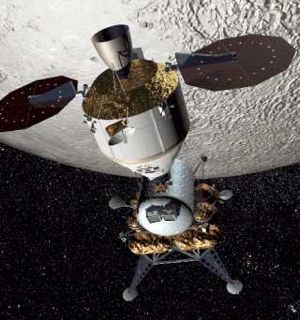 Orion and LASM Credit: NASA |
AKA: MPCV. Status: Operational 2014. First Launch: 2014-12-05. Last Launch: 2014-12-05. Number: 1 . Thrust: 33.40 kN (7,509 lbf). Gross mass: 21,500 kg (47,300 lb). Unfuelled mass: 11,750 kg (25,900 lb). Height: 9.10 m (29.80 ft). Diameter: 5.03 m (16.50 ft). Span: 17.00 m (55.00 ft). Apogee: 85 km (52 mi).
On 31 August 2006 NASA selected Lockheed Martin as the prime contractor to build the Crew Exploration Vehicle, dubbed Orion. Orion's first mission would be to shuttle up to six crew members to and from the International Space Station. It also would serve as a lifeboat for the station crew while docked for up to 210 days with the station. Orion was also designed to transport four crew to lunar orbit and back to earth for NASA's later planned return to the moon. Developments of the spacecraft would also provide the re-entry vehicle for return from any eventual manned Mars missions.
By the date of the contract award NASA had slipped the first launch date by almost four years, to 'no later than 2014'. Any moon landing (which would require funding for development of the Ares V launch vehicle and LSSM lunar module) would not come until 2020 at the earliest.
Lockheed Martin beat out a Northrop Grumman/Boeing team at the conclusion of a two-phase selection process. More than any previous contract, the spacecraft would be designed, developed, and built under NASA direction and on NASA premises. Lockheed Martin was to perform the majority of the Orion vehicle engineering work at NASA's Johnson Space Center, Houston, and complete final assembly of the vehicle at the Kennedy Space Center, Fla. All 10 NASA centers were provided work in terms of 'technical and engineering support' to the Orion project.
The cost-plus-award-fee incentive DDT&E contract was to run from September 8, 2006, through September 7, 2013. Estimated value at award was $3.9 billion. Follow-on delivery orders for production flight vehicles were expected to be issued as early as 8 September 2009. If all options were exercised, delivery orders would be issued through 2019 and had an additional total value of $3.5 billion. Additional 'sustaining engineering' work for Lockheed-Martin would be contracted in the form of task orders, issued concurrent with production delivery orders, with a total value of $750 million through 2019.
Development Cost $: 3,900.000 million. Cost Notes: Development cost. Crew Size: 6. Orbital Storage: 210 days. Habitable Volume: 10.23 m3. RCS Coarse No x Thrust: 16 x 445 N. Spacecraft delta v: 1,855 m/s (6,085 ft/sec). Electric System: 9.15 average kW.
More at: Orion.
| Orion Satellite Systems Orion Satellite Systems, USA. Domestic communications satellite network. |
Family: Manned spacecraft, New Generation Crewed. Country: USA. Spacecraft: Eurostar 2000, HS 601, Orion CM, Orion SM, Orion SA, Orion LAS. Launch Vehicles: Atlas IIA, Delta 8930, Delta IV, Delta 4H, Ares FBB, Ares I-X. Propellants: N2O4/MMH. Launch Sites: Cape Canaveral, Cape Canaveral LC37B. Agency: NASA, El Segundo, Toulouse, Orion Satellite Systems, P. Bibliography: 6756, 12922, 12923.
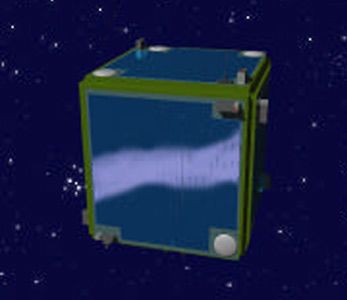 | Orion Credit: Manufacturer Image |
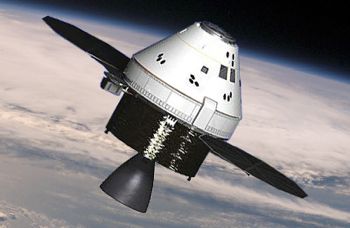 | Orion Credit: Manufacturer Image |
 | Orion EFT-1 Credit: Manufacturer Image |
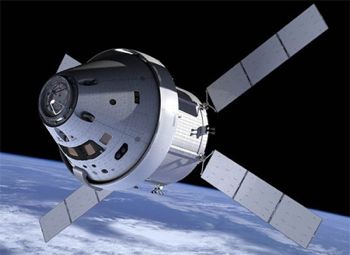 | Orion Credit: Manufacturer Image |
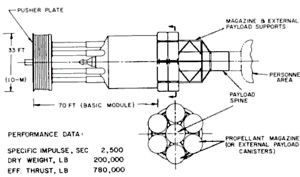 | Orion Upper Stage Orion configured as Saturn V upper stage. |
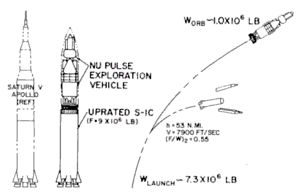 | Orion/Saturn V Orion launch profile on Saturn V |
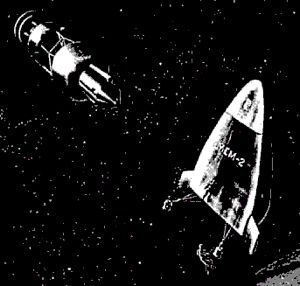 | Orion at Mars Orion nuclear pulse vessel arrives at Mars and releases lander. |
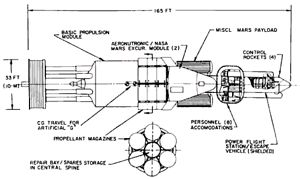 | Orion Mars Configura Orion configured for Mars expedition. |
1994 November 29 - . 10:21 GMT - . Launch Site: Cape Canaveral. Launch Complex: Cape Canaveral LC36A. LV Family: Atlas. Launch Vehicle: Atlas IIA.
- Orion 1 - .
Mass: 2,358 kg (5,198 lb). Nation: USA.
Manufacturer: Toulouse.
Program: Orion.
Class: Communications.
Type: Civilian communications satellite. Spacecraft: Eurostar 2000.
USAF Sat Cat: 23413 . COSPAR: 1994-079A. Apogee: 35,792 km (22,240 mi). Perigee: 35,781 km (22,233 mi). Inclination: 0.00 deg. Period: 1,436.10 min.
34 Ku-band transponders for TV. Stationed at 37.48 deg W. Launch vehicle put payload into supersynchronous earth orbit with IFR trajectory option. Positioned in geosynchronous orbit at 37 deg W in 1994-1999 As of 5 September 2001 located at 37.54 deg W drifting at 0.010 deg W per day. As of 2007 Mar 11 located at 37.60W drifting at 0.015W degrees per day.
1999 May 5 - . 01:00 GMT - . Launch Site: Cape Canaveral. Launch Complex: Cape Canaveral LC17B. Launch Pad: SLC17B. LV Family: Thor. Launch Vehicle: Delta 8930. FAILURE: Engine failure at ignition for second burn of Centaur stage.. Failed Stage: U.
- Orion 3 - .
Payload: HS 601HP. Mass: 4,300 kg (9,400 lb). Nation: USA.
Agency: Palo Alto.
Manufacturer: El Segundo.
Program: Orion.
Class: Communications.
Type: Civilian communications satellite. Spacecraft: HS 601.
USAF Sat Cat: 25727 . COSPAR: 1999-024A. Apogee: 2,529 km (1,571 mi). Perigee: 2,456 km (1,526 mi). Inclination: 19.80 deg. Period: 138.60 min.
The Centaur RL-10B-2 second stage engine's combustion chamber ruptured at the beginning of the second burn. The hot gases already in the chamber vented, putting the stage/spacecraft assembly into an uncontrollable tumble. The Orion 3 communications satellite ended up in a useless parking orbit of 162 km x 1378 km x 29.5 deg. It was to have served the Asia-Pacific region for Loral Orion with 33 Ku-band and 10 C-band transponders.
1999 October 19 - . 06:22 GMT - . Launch Site: Kourou. Launch Complex: Kourou ELA2. LV Family: Ariane. Launch Vehicle: Ariane 44LP.
- Orion 2 - .
Mass: 3,814 kg (8,408 lb). Nation: USA.
Agency: Arianespace.
Manufacturer: Palo Alto.
Program: Orion.
Class: Communications.
Type: Civilian communications satellite. Spacecraft: FS-1300.
USAF Sat Cat: 25949 . COSPAR: 1999-059A. Apogee: 35,798 km (22,243 mi). Perigee: 35,774 km (22,228 mi). Inclination: 0.00 deg. Period: 1,436.10 min.
Satellite used for international communications; complement the Telstar satellites operated by Loral Skynet. Stationed at 15 deg W. Positioned in geosynchronous orbit at 15 deg W in 1999. As of 6 September 2001 located at 14.97 deg W drifting at 0.006 deg W per day. As of 2007 Mar 10 located at 14.99W drifting at 0.006W degrees per day.
2014 December 5 - . 12:05 GMT - . Launch Site: Cape Canaveral. Launch Complex: Cape Canaveral LC37B. Launch Pad: Cape Canaveral SLC37B. LV Family: Delta IV. Launch Vehicle: Delta 4H.
- Orion EFT-1 - .
Mass: 9,400 kg (20,700 lb). Nation: USA.
Class: Manned.
Type: Manned spacecraft. Spacecraft Bus: Orion CEV.
Spacecraft: Orion.
Decay Date: 2014-12-05 . USAF Sat Cat: 40329 . COSPAR: 2014-077A. Apogee: 5,809 km (3,609 mi). Perigee: -37 km (-37 mi). Inclination: 28.80 deg.
Exploration Flight Test 1 used an Orion Crew Module (probably around 9400 kg) with an LAS launch escape tower, atop a dummy Service Module with jettisonable side panels, which in turn was fixed to the OSA (Orion-to-Stage-Adapter). This vehicle was mounted on the second stage of a Delta IV Heavy vehicle 369. Delta 369's second stage was inserted into a 185 km x 888 km x 28.8 deg orbit at 12:22 GMT, 17 minutes after launch. The stage made a second burn at 14:00, entering a -37 km x 5.807 km orbit; apogee was at 1510. At 15:28 the Orion CM separated from the stage. The Orion CM made a small RCS adjust burn at 16:02 and entered the atmosphere at 8.9 km/s at 16:18, landing at 16:29 off Baja California at 23.60 deg N x 116.46 deg W. It was recovered by the USS Anchorage.
Back to top of page
Home - Search - Browse - Alphabetic Index: 0- 1- 2- 3- 4- 5- 6- 7- 8- 9
A- B- C- D- E- F- G- H- I- J- K- L- M- N- O- P- Q- R- S- T- U- V- W- X- Y- Z
© 1997-2019 Mark Wade - Contact
© / Conditions for Use